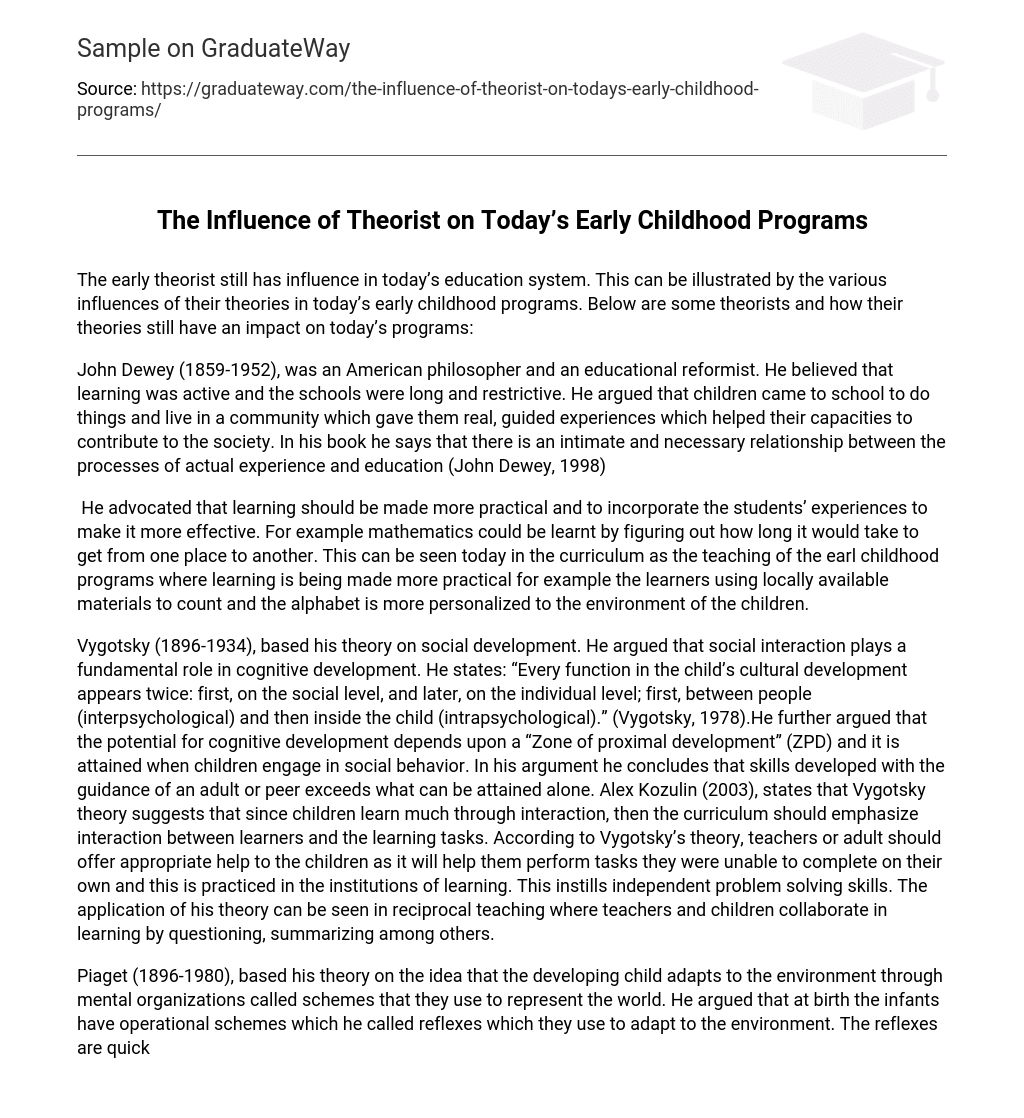The early theorist still has influence in today’s education system. This can be illustrated by the various influences of their theories in today’s early childhood programs. Below are some theorists and how their theories still have an impact on today’s programs:
John Dewey (1859-1952), was an American philosopher and an educational reformist. He believed that learning was active and the schools were long and restrictive. He argued that children came to school to do things and live in a community which gave them real, guided experiences which helped their capacities to contribute to the society. In his book he says that there is an intimate and necessary relationship between the processes of actual experience and education (John Dewey, 1998)
He advocated that learning should be made more practical and to incorporate the students’ experiences to make it more effective. For example mathematics could be learnt by figuring out how long it would take to get from one place to another. This can be seen today in the curriculum as the teaching of the earl childhood programs where learning is being made more practical for example the learners using locally available materials to count and the alphabet is more personalized to the environment of the children.
Vygotsky (1896-1934), based his theory on social development. He argued that social interaction plays a fundamental role in cognitive development. He states: “Every function in the child’s cultural development appears twice: first, on the social level, and later, on the individual level; first, between people (interpsychological) and then inside the child (intrapsychological).” (Vygotsky, 1978).He further argued that the potential for cognitive development depends upon a “Zone of proximal development” (ZPD) and it is attained when children engage in social behavior. In his argument he concludes that skills developed with the guidance of an adult or peer exceeds what can be attained alone. Alex Kozulin (2003), states that Vygotsky theory suggests that since children learn much through interaction, then the curriculum should emphasize interaction between learners and the learning tasks. According to Vygotsky’s theory, teachers or adult should offer appropriate help to the children as it will help them perform tasks they were unable to complete on their own and this is practiced in the institutions of learning. This instills independent problem solving skills. The application of his theory can be seen in reciprocal teaching where teachers and children collaborate in learning by questioning, summarizing among others.
Piaget (1896-1980), based his theory on the idea that the developing child adapts to the environment through mental organizations called schemes that they use to represent the world. He argued that at birth the infants have operational schemes which he called reflexes which they use to adapt to the environment. The reflexes are quickly replaced with constructed schemes as they develop Piaget’s theory emphasizes that the curriculum must be designed to suit the development stage of the children and this will enhance their logical and conceptual growth. Discovery learning and supporting the interests of the child are instructional techniques modeled on his theory. Children should be challenged to develop cognitively but material should be not too far beyond the child’s level. For example children are first taught the alphabet but only start constructing words once they have mastered it. Also teachers must acknowledge the critical role played by experiences derived from the interaction with the surrounding environment in the student learning (Huitt & Hummel, 2003)
Maria Montessori (1870-1952), approach is based on independent learning by the children by providing an environment of activities and materials which children use at their own pace. This helps them to build self confidence, inner discipline and a sense of self worth. She emphasizes on the role of the teacher being to introduce new materials and they observe the child interacting with the environment and from this they can base when to introduce new materials and avenues for learning.(Montessori & Hunt, This is seen in most early childhood programs where the children learn through the experiences they get from the environment. For example the classes are filled with toys and other educational materials and the children are left to interact with them and the teacher acting only as a guide. Also she emphasized on repetition which helps the child to perfect his or her skills. This is seen in many classes where children keep on repeating words and the alphabet till they internalize them.
Erik Erickson (1902-1994), is best known for his eight-stage model of the human cycle. This model identifies particular goals challenges and concerns at each stage of life. He asserts that the stages are interdependent in that unresolved conflicts at one stage influence development at later stages.(StateUniversity.com) The different stages are vital in early childhood programs for example for kindergartens, they are allowed to dress, feed and do stuff for themselves thus helping them to be initiative and not feel guilty about it. Also in the industry vs. inferiority the teachers encourage the children by supporting their strong points therefore not making them feel inferior to their mates. This is very important as it boosts their confidence.
The early theorists have had influence in today’s programs and although they may not be very direct, the influence is significant to the education program.
References
Dewey J. (1998), Experience and education, Kappa Delta Pi Publications; 60 Anv edition
Huitt, W., & Hummel, J., (2003), Piaget’s theory of cognitive development, Educational Psychology Interactive, Valdosta State University, Retrieved 19, March 2009, from http://chiron.valdosta.edu/whuitt/col/cogsys/piaget.html
Kozulin, A., Gindis, B., Ageyev, S. V., Miller, S. M., (2003), Vygotsky’s Educational Theory in Cultural Context (Learning in Doing: Social, Cognitive and Computational Perspectives), Cambridge Educational Press.
Montessori, M., & Hunt, J., (2005), The Montessori Method, Kessinger Publishing.
StateUniversity.com, (n.d), Erik Erikson, (1902–1994) – Career, Contribution,
Viewed on 30, March 2009,
http://education.stateuniversity.com/pages/1960/Erikson-Erik-1902-1994.html
.





